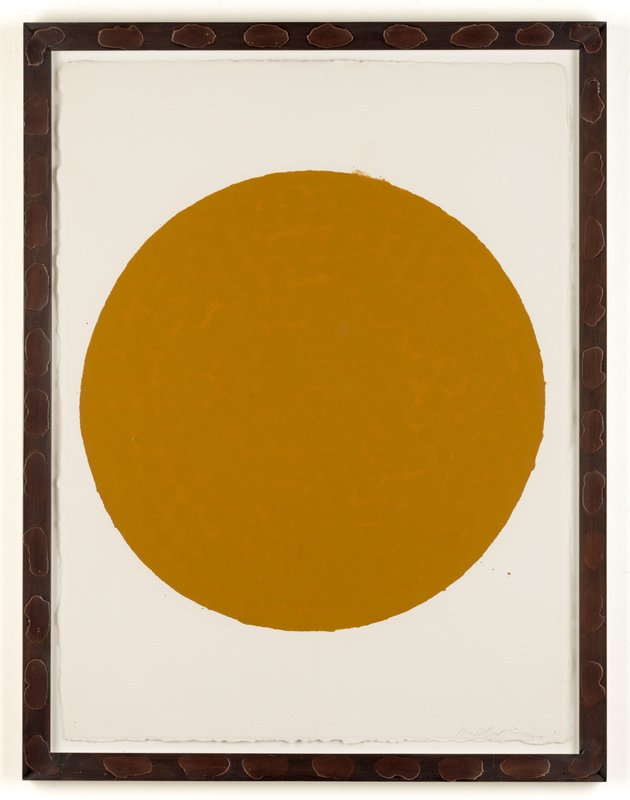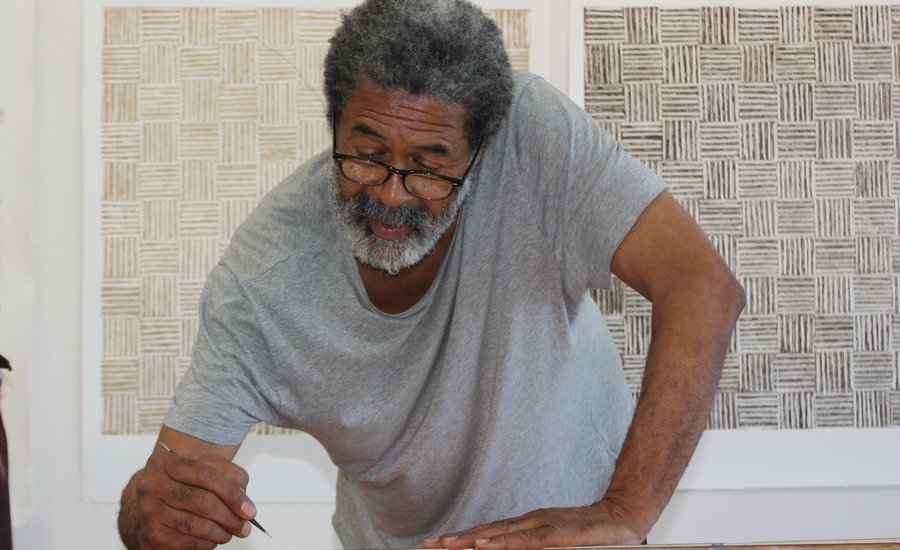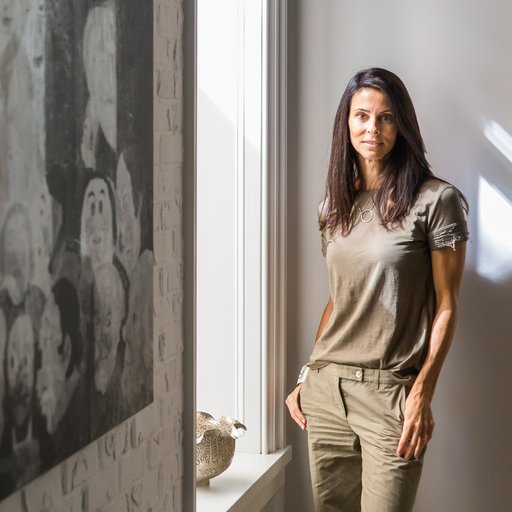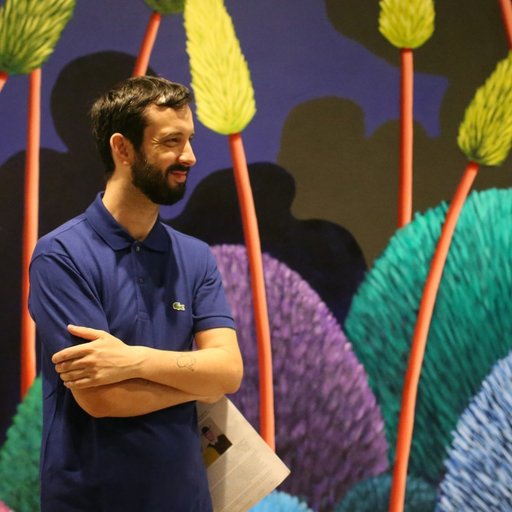At the age of 70, McArthur Binion says he’s only just beginning. The abstract painter spent his twenties in New York, partying with the star-studded downtown crowd, and turning down teaching jobs to paint full time. He spent decades honing his craft, but according to the spirited artist, he only began making truly great paintings this past year. And Binion isn't the only person who's excited about the work he's been making recently.
His expressionistic, grided abstract paintings have garnered significant (albiet long-overdue) attention—in the past four years, the now Chicago-based artist has held three solo exhibitions at Kavi Gupta Gallery in his hometown, as well as solo exhibitions the Contemporary Art Museum in Houston and Galerie Lelong in New York.
Now, enjoying his success later in life, Binion is as confident as he is wise, and his enthusiasm for the emotive potential of painting is palpable. For the latest installment of our interview series around Phaidon 's Vitamin P3 compendium of contemporary painting , Artspace ’s Loney Abrams met the painter in MoMA's courtyard to discuss how the New York art scene has changed since the ‘70s, Binion’s experience as the rare black artist downtown, and his secret to finding success later in life.
While you were living in New York in the '70s, you were painting but you weren't exhibiting much. Now, after moving to Chicago and turning 70, your career is taking off. What was it like to be an artist in New York at that time without an outlet to show your work?
How do I say this in some kind of way that’s not nasty… To be blunt with you, I turned down what’s happening to me now, in the 1970s. I had many offers to show, but no one knew what was going on with the work, and so I said “no.”
So you deliberatly chose not to show your work?
It was a choice because it was, and still is, very important to me that my work is seen in a certain way. Also, there weren’t any black people downtown, to be blunt. I was a black person that knew white people [laughs.] I was invited everywhere, and I was a part of the scene, but I didn’t want to be the only black person out there. It was like, Romare Bearden and that was it. [Laughs.]
Did you feel isolated?
No. I was in the scene, I went to openings, huge parties, but I knew my work wouldn’t have been seen the way I wanted it to be seen. Back then, people were describing me as a Minimalist artist, and for me, my work had much more emotional content.
It seems that because your work is so emotional and personal, and because you’re African-American, people read into it as being about identity and race somehow. But I get the sense that it’s not.
It’s not. [Laughs.]
Is it problematic that people read it in that way?
It’s not my problem. That’s their problem. It’s very easy for writers and viewers to see race in work, because black people were only recently honored in society at all. But Loney, the important thing is, there is no historical line running through me. I made myself up! [Laughs.]
 McArthur Binion,
honey: two
(2016) oil paint stick and paper on board, image courtesy of
Kavi Gupta Gallery
McArthur Binion,
honey: two
(2016) oil paint stick and paper on board, image courtesy of
Kavi Gupta Gallery
In the last four or five years, your career has really taken off. Why now?
The work speaks for itself. But also, let’s just face it: white people have made contributions to art for centuries. So it’s really important to the world at large to discover us, to really, really, really take a good look. Now, when you find someone that has no line going up through them historically, it’s interesting. I feel like at 70 years old, I’m just beginning. It’s wild! But it’s so good. I have a Rolodex here [points to his temple] of paintings you wouldn’t believe. There’s a thousand paintings sitting right there that I can do for years.
Your abstract paintings are biographical in that underneath the surface of the painting you’ve layered photographs and documents that are linked to your past in some way. Why is it important to insert yourself into your paintings?
The geography of my life becomes what I call the under-consious of the work. It includes my one telephone book that I’ve kept from 1972 to the ‘90s. In the ‘70s and ‘80s, there were only three ways to communicate with people: face-to-face, telephone, or U.S. mail. Everyone I knew was always in my phonebook. Before the internet and all that stuff, it was… not slower, necessarily, but much more intimate, particularly in New York. People actually saw each other, had conversations with each other, and talked to each other as opposed to connecting on the internet. The under-conscious of the works speaks to that.
Who’s in your phonebook? Who were you hanging out with in the ‘70s and what was the scene like?
Everybody’s in my phonebook, from Dan Flavin , to Jean-Michel Basquiat , to David Hammons , to Kerry James Marshall , to Brice Marden , Ronald Bladen, and Sol LeWitt . Every Saturday, someone had a party. And they were open parties—you’d go to a party at Gordon Matta-Clark ’s studio and anyone could be there. The only people that had security guards at parties were people like Rauschenberg because he was famous already. Aside from him, it was pretty much open. I’m a very social person, in a quiet way, but I knew everybody. Everybody did.
Where did you live?
My first place was 33 Greene Street, then I moved way downtown to TriBeCa. I was at 109 West Broadway, and then I moved to Chelsea before Chelsea was Chelsea, in December of 1975. I had a 5,000 square foot loft with two huge skylights. The whole floor was $700 with a 10 year lease without a yearly raise.
Oh my god.
But the point is, darling, you could be in New York and actually be an artist and not have a lot of money. That’s the most tragic thing that happened to New York. People like me cannot live there anymore. I moved out of New York 25 years ago. New York is a hard place to get work done. I don’t care who you are, I don’t care how much money you have, it’s just hard to get work done and this is why so many artists have so many people working for them in their studios. In Chicago, it’s easy to get the work done, cost of living’s half, and it’s just like, whoo .
What do you think’s going to happen to New York?
It’s already happening, my dear.
Do you see people coming from New York to Chicago? Or is it still a hidden gem?
No, no. The one thing that’s good about New York, is that they do have respect for younger artists. In a place like Chicago, there’s much less support for younger artists. People like me, who in the past may have gone art school, move here and go to medical school, or business school, or law school, because there’s no future in being an artist. The smart black people, the really brilliant black people, they went to law school, they went to medical school, and they did super well. And those people are the people that buy black art.
If you know what’s good for you, you stay the hell away from art.
Right. But the thing is that in New York in the ‘70s, you could stand on the corner of West Broadway and Spring Street for an hour or two on Saturday afternoon, and you would literally see everybody that exists in the art world, because people came out on Saturday afternoons. And what happened in 1980 when John Lennon got killed, people stopped coming out. Stars stopped coming out.
Really? Because they were scared of getting shot?
It changed New York. People hired bodyguards. But before that, you could see the art world just by walking outside in New York. There wasn’t any color, they were all white, except Romare Bearden .
You say the you were the only black guy at openings in the ‘70s. I hate to say it but, aren’t you still one of the only black guys at openings today? The art world is still very, very white.
It was white, and it’s still white—and that’s just life itself. It’s the same thing, it’s the same thing, it’s the same thing.
In the ‘70s, did you think that the art world in 2016 would still lack diversity?
Yep.
You mentioned that smart black people don’t enter the art world because they follow career paths that are less risky—like law, medicine, et cetera. Do you really think that’s the only reason there aren’t more artists of color? Do gatekeepers have anything to do with it?
Yes, of course. I think both of those reasons are right. But right now, there’s a huge amount—well by huge I really mean like five dozen or maybe a hundred—of super good black artists that are highly considered, that are in all the museums, and they’re all born during the ‘60s and ‘70s. And they’re huge. And they’re also really good artists. But back in the ‘70s when I came here, there weren’t that many artists of color. There weren’t that many black artists. I don’t like the term “artists of color.” I think it’s fucking disgusting. I’m not an artist of color, I’m a black artist. Artist of color... what am I, green or some dumb shit? [Laughing] Artist of color—disgusting.
Yeah, I guess it’s trying to be inclusive, but the term ends up implying that white is the default, and then everyone else is lumped together as a single “other.”
Exactly. [Laughs.] There’s white, and then people of color. Excuse me? [Laughs.]
 McArthur Binion,
MAB: 1947: E
(2016). Image courtesy of Kavi Gupta Gallery.
McArthur Binion,
MAB: 1947: E
(2016). Image courtesy of Kavi Gupta Gallery.
What were you making in New York in the ‘70s?
With the work from the 70s, I used wax-based crayons on aluminum. That’s what I innovated. The crayons were marking pens used in lumber yards and steel mills, and I’m the first person to ever use them for art. I wanted to break the tradition. I don’t come from art history. I made myself up. I went to art school as a creative writing major and started as a writer. I didn’t go to an art museum until I was 19 years old.
What was that experience like?
It was amazing. I’d never seen paintings before. When I dropped out of school, I took a job as an associate editor of a magazine in Harlem. The editor would send me on errands. I came to the Museum of Modern Art to deliver a package to the president of the museum and on that errand, I saw a painting for the first time. It changed my life. I saw that painting could be of a philosophical nature. I really had no idea what painting was or what painting could be until that moment. I was still writing—I was a young poet at the time. But after seeing paintings at the MoMA I took a drawing class for the first time a couple of years later, around the time of Woodstock. And I was really good at most everything I’ve tried—I was a great athlete, et cetera, but when I took the drawing class, it was the most emotionally painful thing I’d ever tried.
Because you weren’t good at it?
I had no clue. I was 21 at the time, and that class was so emotional. I was crying like a baby, it was just so emotional. I drew for 40 hours a week for 2 years straight and I caught up. I got it. That was in 1969, and I stayed with it. But the main thing is, my work comes from the same place that poets and jazz musicians come from. I am not necessarily influenced by those two mediums, but the work comes from the same place.
Which is where?
I’ll say, it doesn’t come from museums. It comes from the interior emotionality of me. This is my first time ever putting those words together—the interior emotionality of me.
There’s a personal history there. I’m one of 11 children. I lived in a two-bedroom house with one bathroom for 13 people. As a child, one of the things that influenced me, was that I slept under a quilt my mother made, and I still have it. Quilts are made from discarded shirts and pants, and stuff like that. I was raised to use everything you have. When I went to art school, I used oil paints like everyone else, but I didn’t get the results I wanted, because oil paintings were made by people in museums. I came from somewhere else.
You grew up in Mississippi on a cotton farm, is that right?
I grew up in Mississippi and lived there until I was 4-and-a-half years old. Then I moved to Detroit with my family.
In Detroit your parents worked in factories. Is it fair to say that your art—which is labor intensive, repititious, and uses industrial materials—is somehow connected to labor?
It’s kind of fair, but to me, the factory is just about hard work. I work every day in my studio that I’m in town. I leave for my studio between 7:00 and 7:30 in the morning, and I work until between 4:00 and 5:00—so I have a workday. And also, my hands are the only hands that put paint on my paintings. I don’t have someone painting my paintings. But for me, for me my work has no language—it has a language of itself.
 McArthur Binion's
Untitled
(2004) is available on Artspace for $8,000
McArthur Binion's
Untitled
(2004) is available on Artspace for $8,000
What are you working on in the studio now? What shows do you have coming up?
There’s a major European show next year that hasn’t been announced yet so I can’t say. But it’s like, the shit. So, once the show happens in Europe, it’s going to be over. The way I see it Loney, every time I go into the studio, I challenge somebody—either Johns, Bearden, Cy Twombly —like it’s a heavyweight championship fight. I go in there and crush them. [Laughs.] Every day I’m in the studio I challenge somebody, something, in a real fierce way. It’s not like, “Oh, I’m going to challenge Cy.” No, it’s “I’m going to buy your ass!” [Laughs.]
Are the paintings your working on now a lot different than what is up right now at Kavi Gupta ?
They’re a lot better. I mean, it’s the same kind of content, but more rich and more about color. These paintings are the best. It’s the first time in my life as an artist I can say clearly and loudly that these paintings are good! All the paintings that came before now, they were ok. They were very well done, et cetera. But as far as me saying, “these are good paintings,” this is the first I’ve said that in my life.
How do you know when a painting is good? How can you tell when it’s finished?
It’s just so huge. When you are there, it becomes obvious. My goal as a young artist and still up to last year, is that I’m still trying to make a really good painting. That’s the goal. And I’m starting to think that I am, [laughing] which is so major to me. When I’m in the studio, I laugh a lot, I cry a lot, and I’m with no music, no sound, no nothing. So, everything’s going out, and ain’t nothing coming in. I don’t want anyone else’s genius coming in and blocking my shit. In the cases when I do listen to music, I only listen to music of people that I know. Like Ornette Coleman, Cecil Taylor, Don Cherry—artists who are alive and dead.
And you know what? I couldn’t do this in New York and still exist because it’s just such a hard, hard place to live. I discovered a long time ago, in the '70s, that the only way to successfully live in New York is to also have a place outside of New York. That’s the only way to survive this place.
Do you have any advice for young artists who are trying to make it in New York? Is it, give up and go somewhere else? Or is it, try to make it work in New York, even if it means limiting your studio time by having to work 60 hours a week?
Well, number one, you have to believe in yourself, hugely. And also, there’s a job, there’s a studio, and there’s a social life. If you live in New York, you can’t exist without the social life. You just can’t, because it’s too hard. And then you have the job, and you can’t do all three well. You can’t. Unless you have trust fund. Therefore, most artists have trust funds, I’m sure [laughs]. I don’t want to be talking shit about that though, because a lot of those people are my friends.
My first friend in New York was Judy Pfaff . We were at the same place, born the same month, same year, had the same kind of focus, and we used to go to Springstein’s bar after working all day, and sit at the bar and drink, and talk about art for two hours. [Laughs.] And back then, you could be in the studio. The reason why I stopped teaching was because the people that I admired like Dan Flavin and Ronald Bladen and people like that, they worked in the studio all day! They didn’t have teaching jobs. So I’m thinking “Yo, I’m 27, I quit this job, I don’t know how I’m going to make it but I’m going to fucking make it.”
How did you make it, did you just lived super cheaply?
I’ve never lived cheaply my entire life. I’m a born hustler, since 7 years old. I never wanted anything I couldn’t get. Because you just go get it. But the important thing, Loney, I fucking made myself up. [Laughs.]
I love how much you get a kick out of saying that—that you made yourself up. You’ve said it a few times and everytime it makes you chuckle like nothing else.
Well, the reason is I think very few people can say that. And also, no one can take it from me. It’s mine! That’s why I laugh about it. It’s fucking mine! I can do anything I want to do, and it’s not going to change what’s happening for me, because I made it up.
























